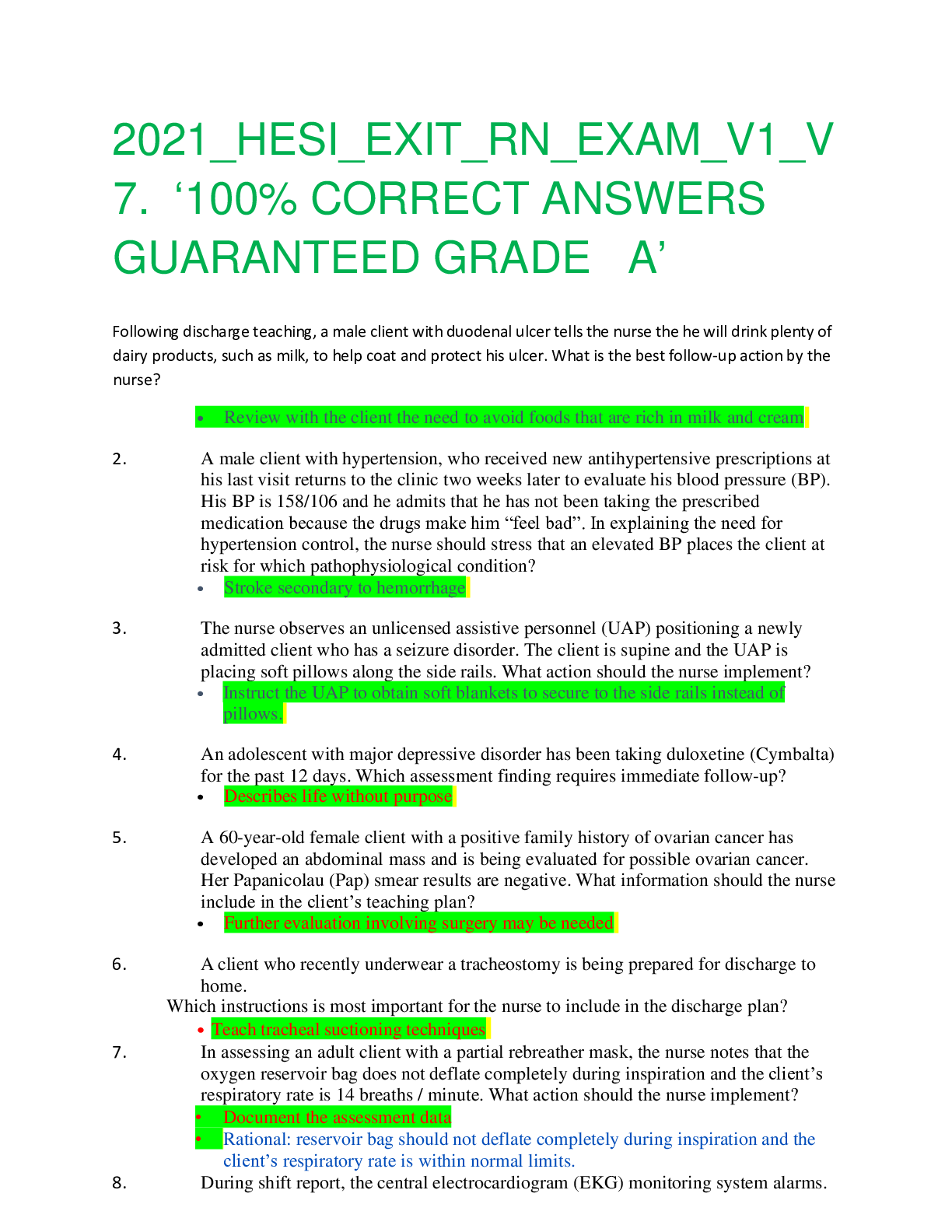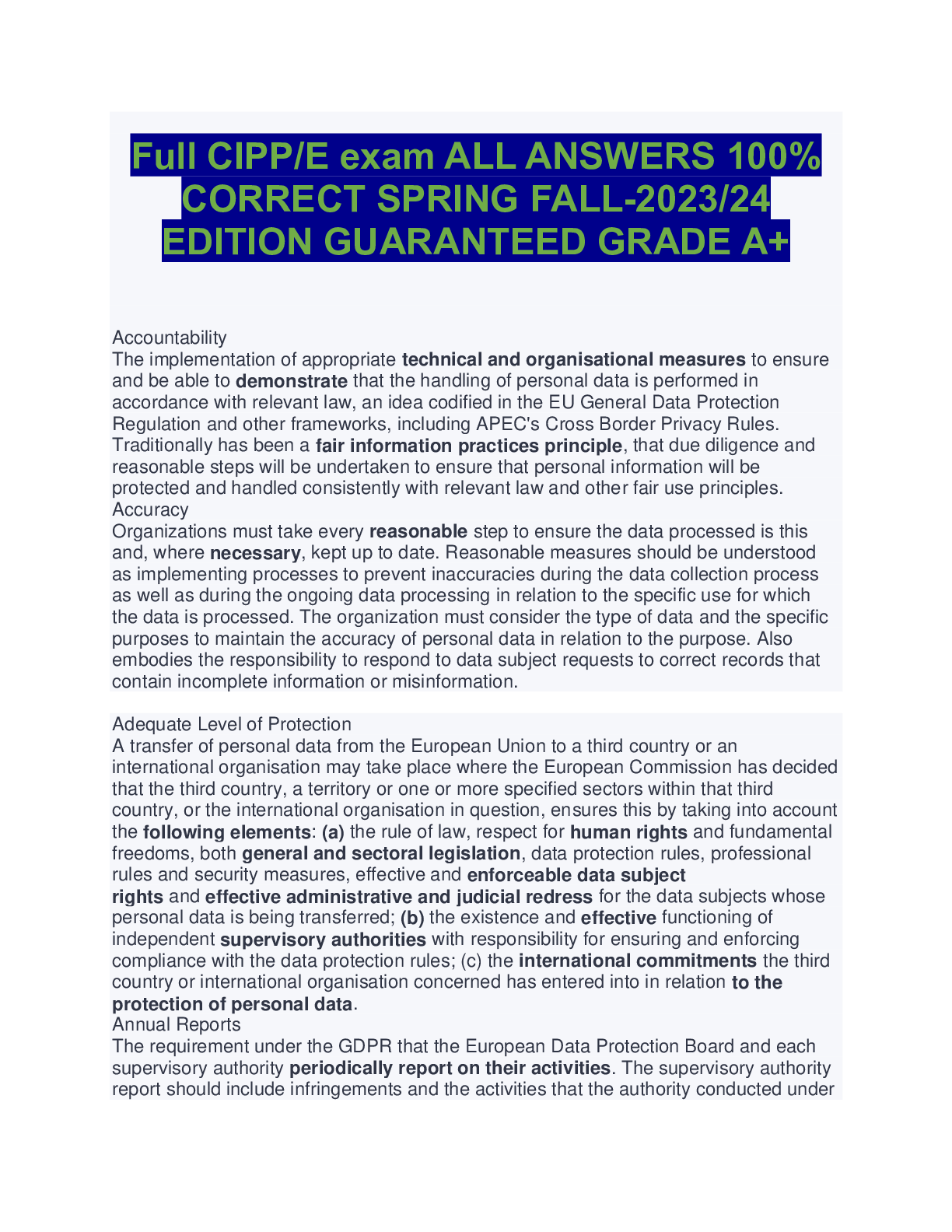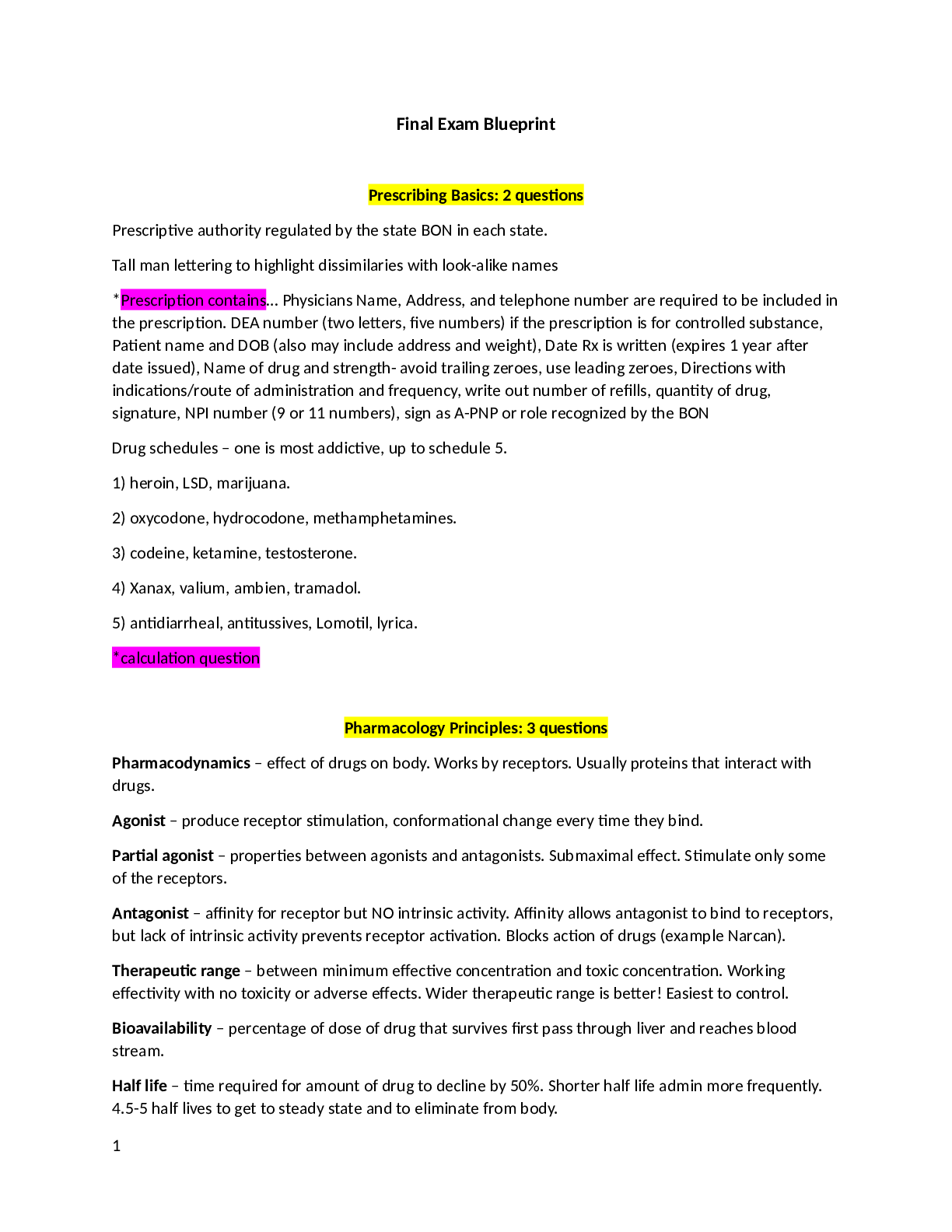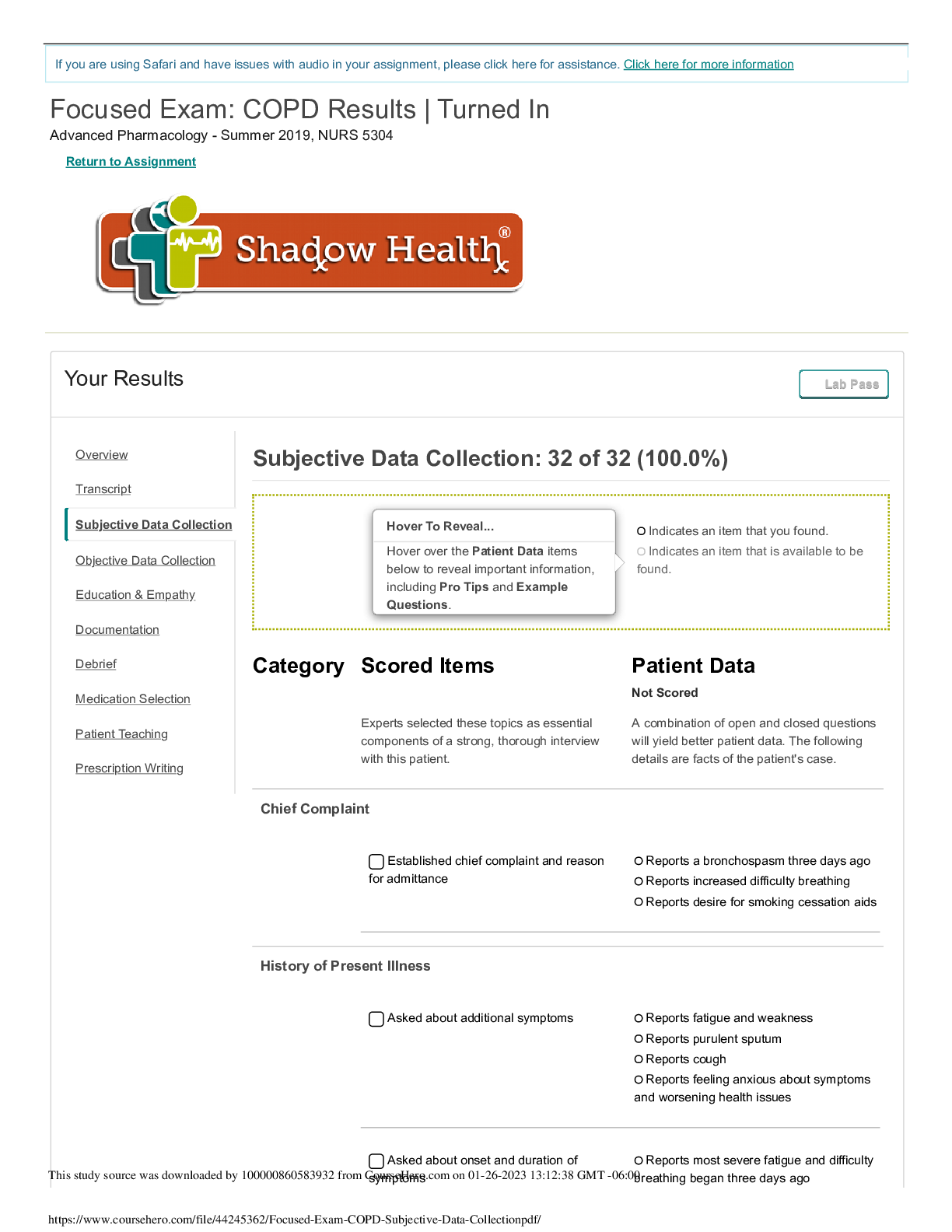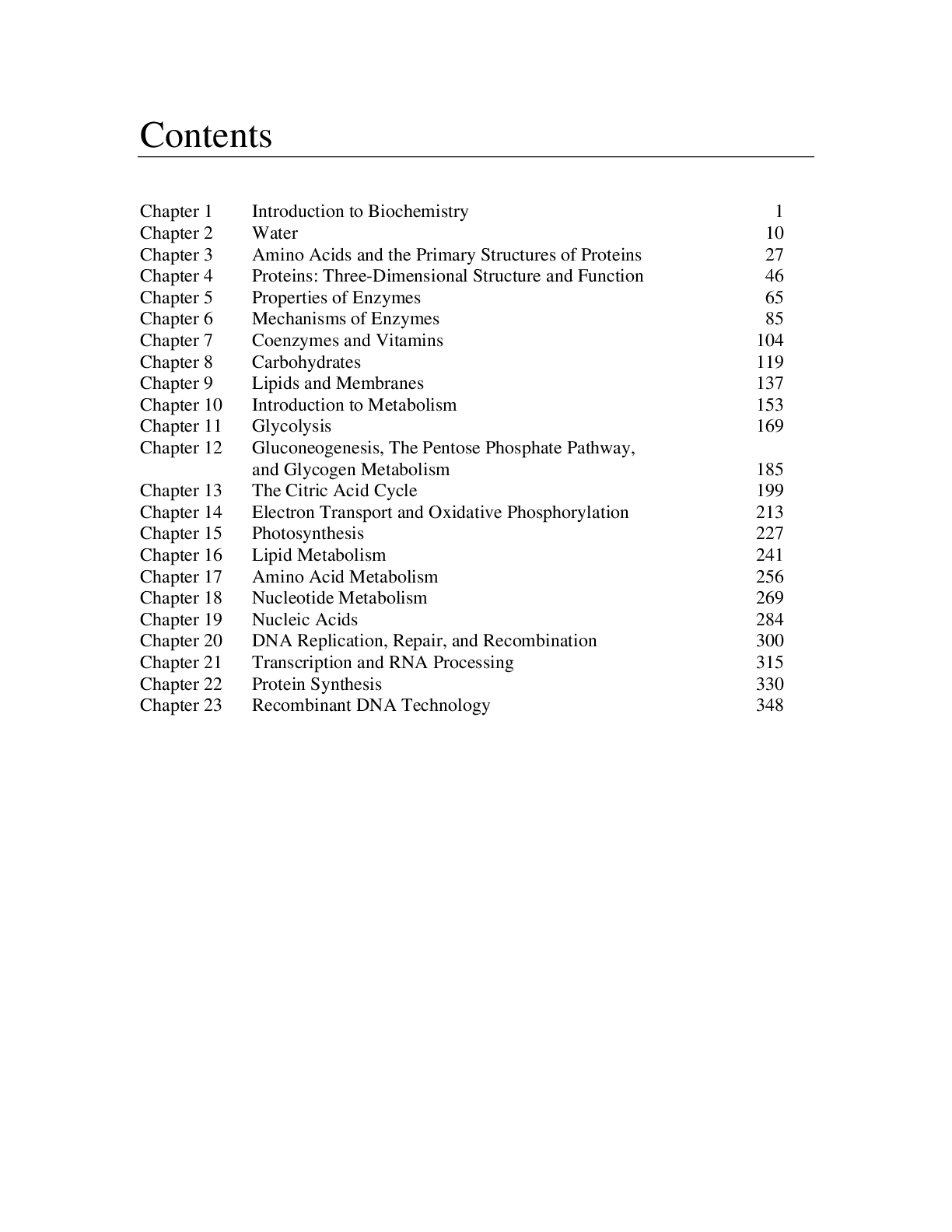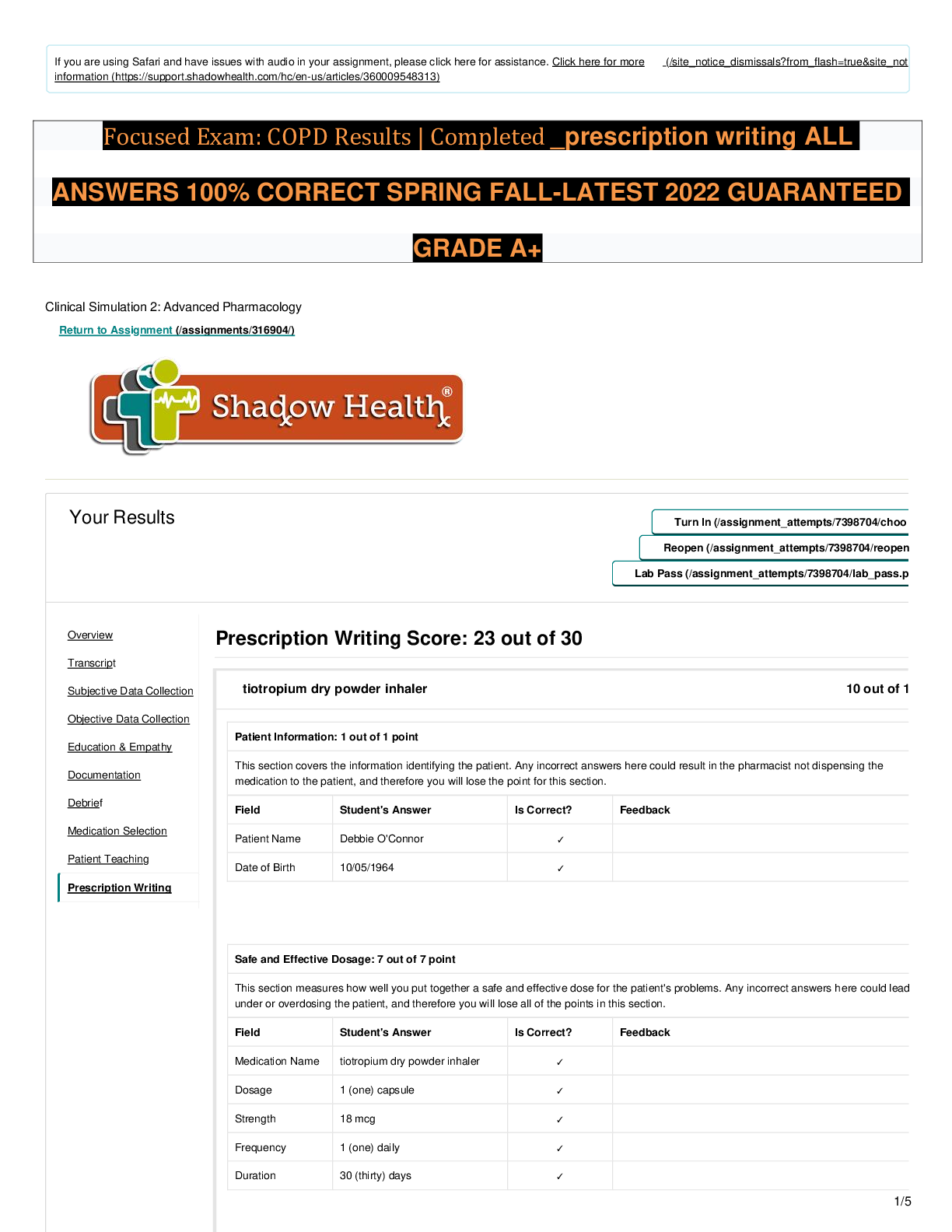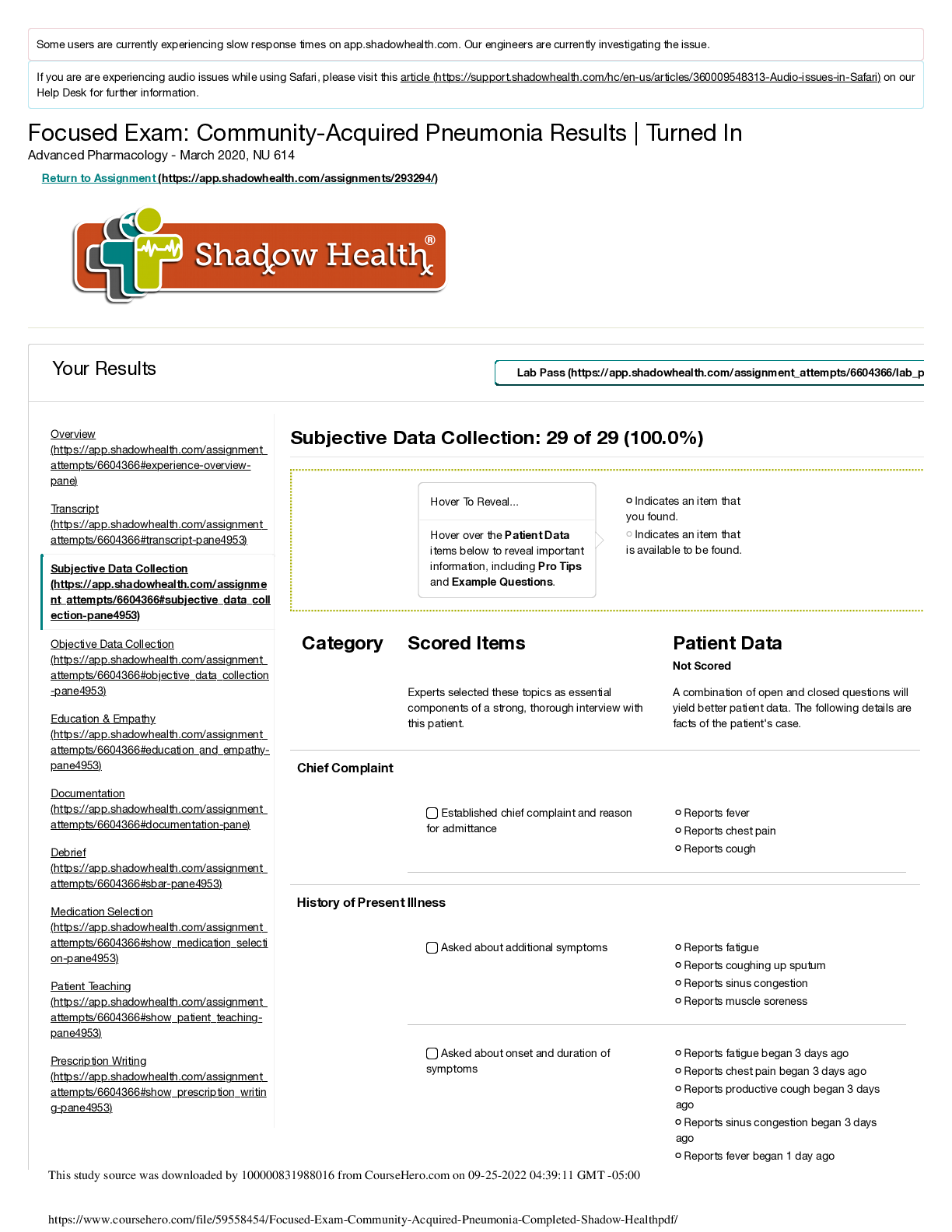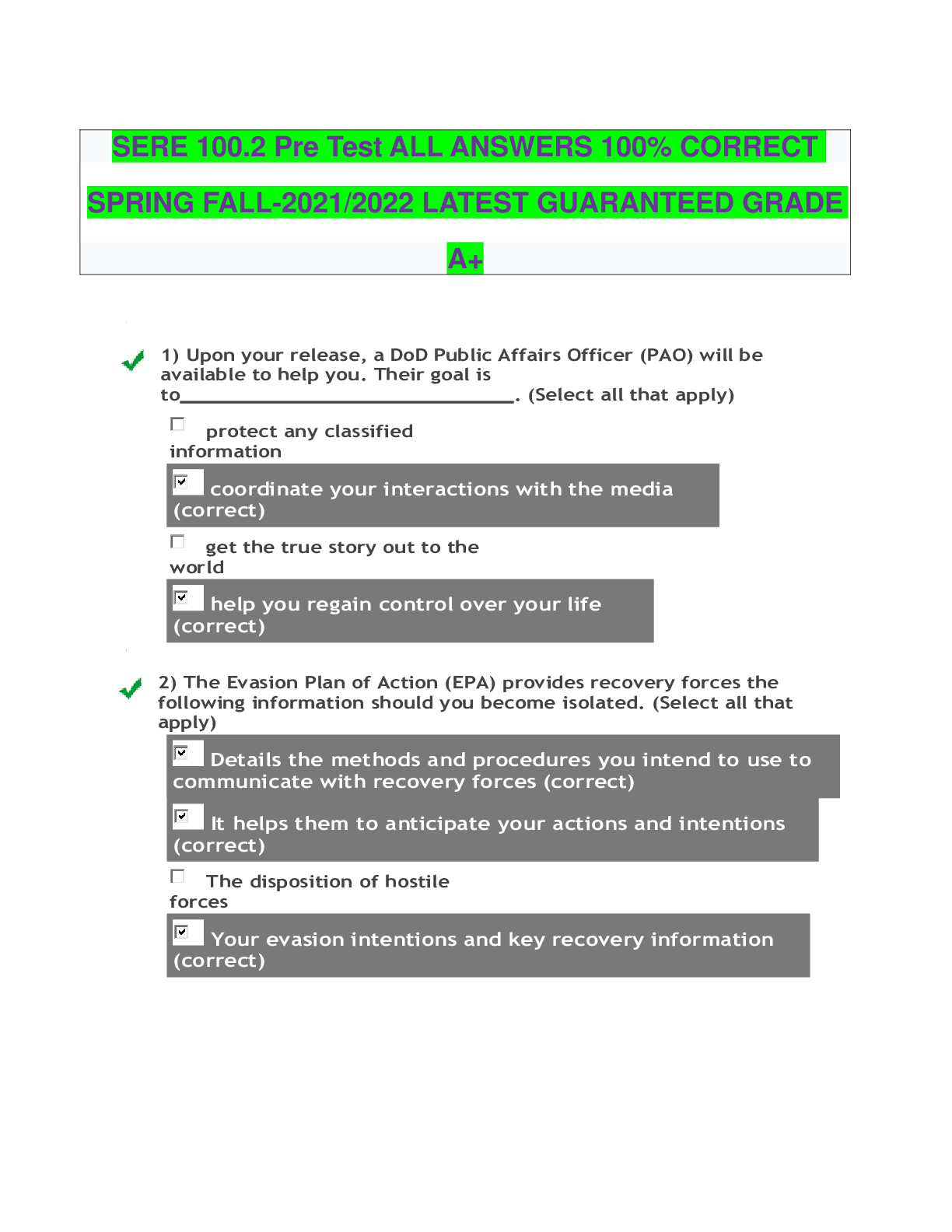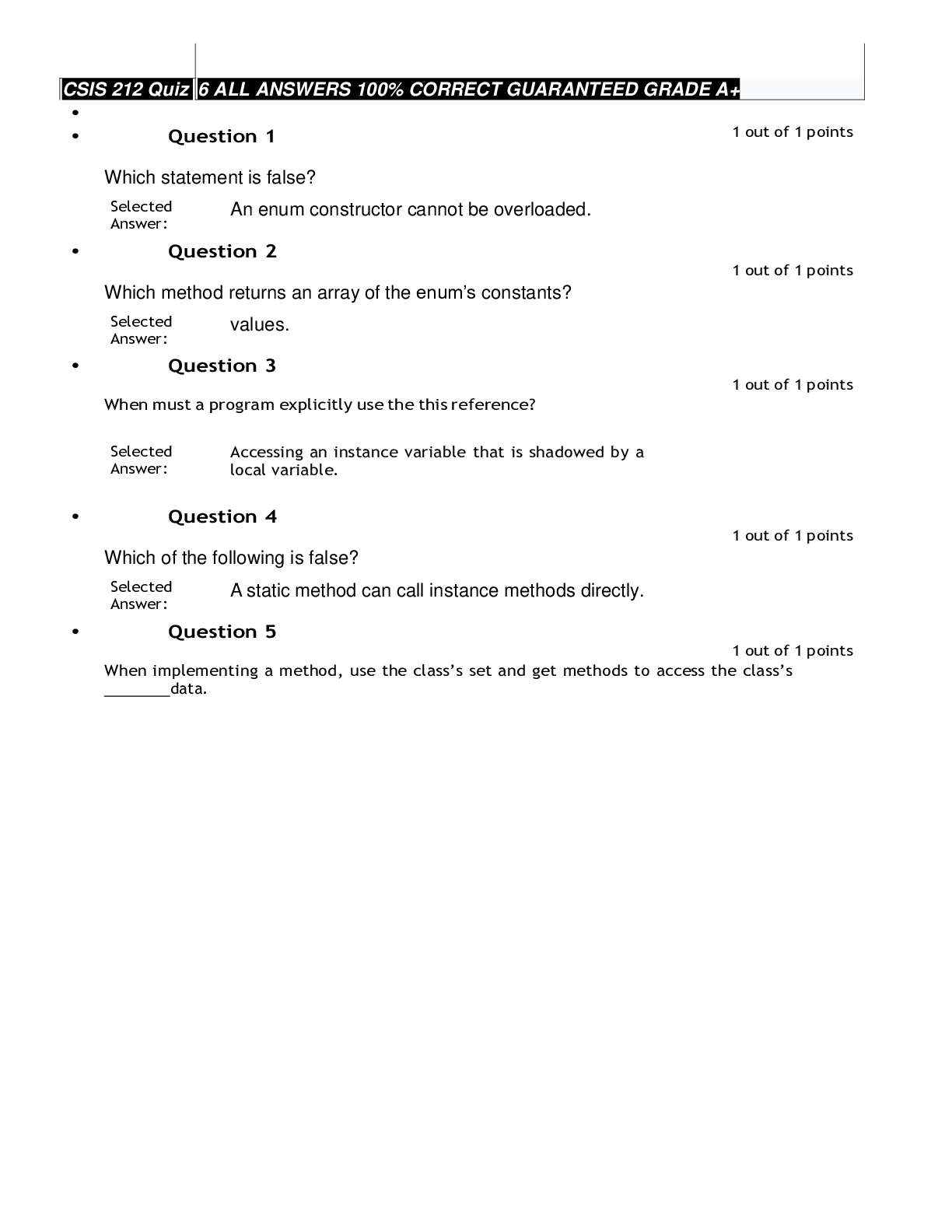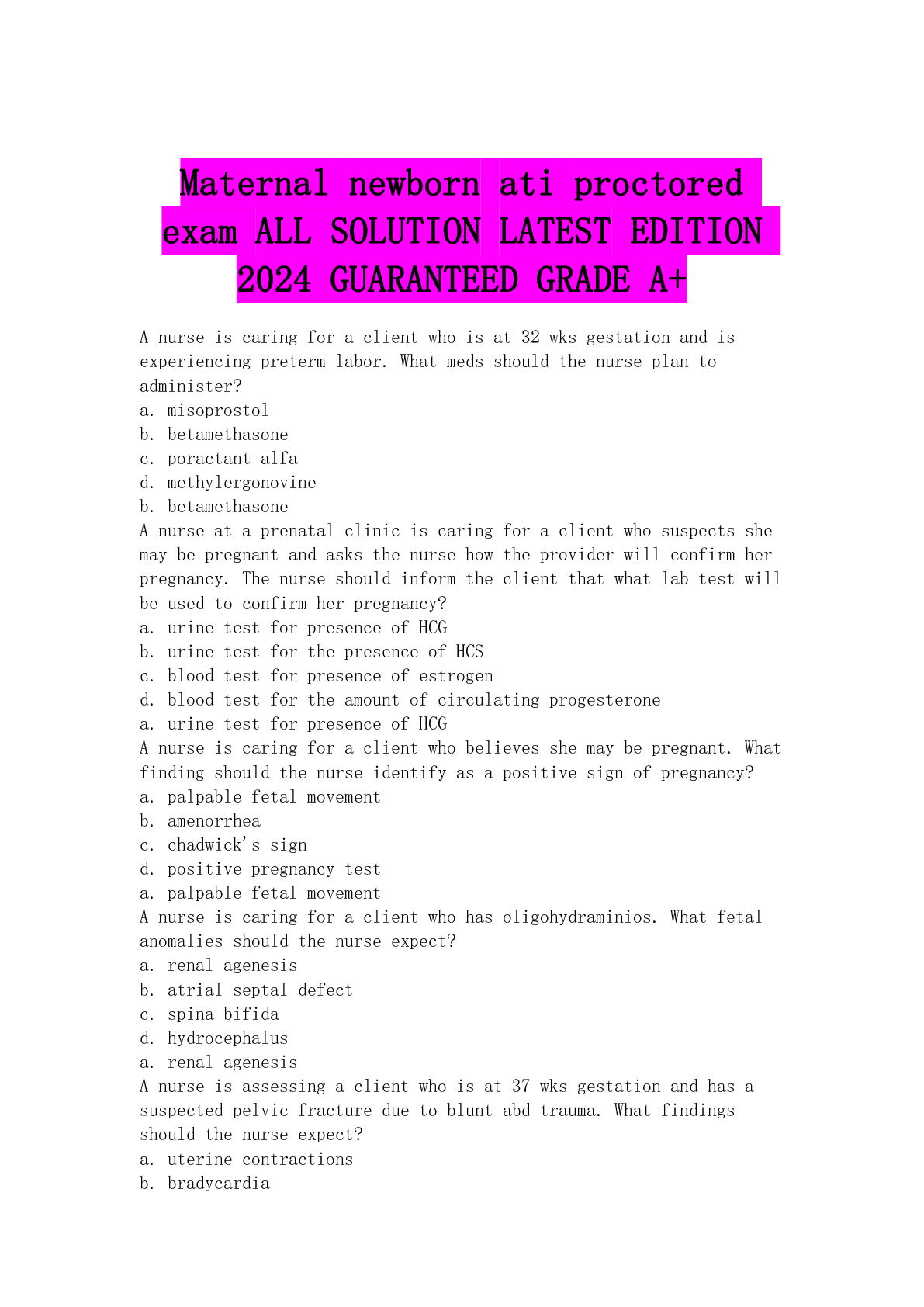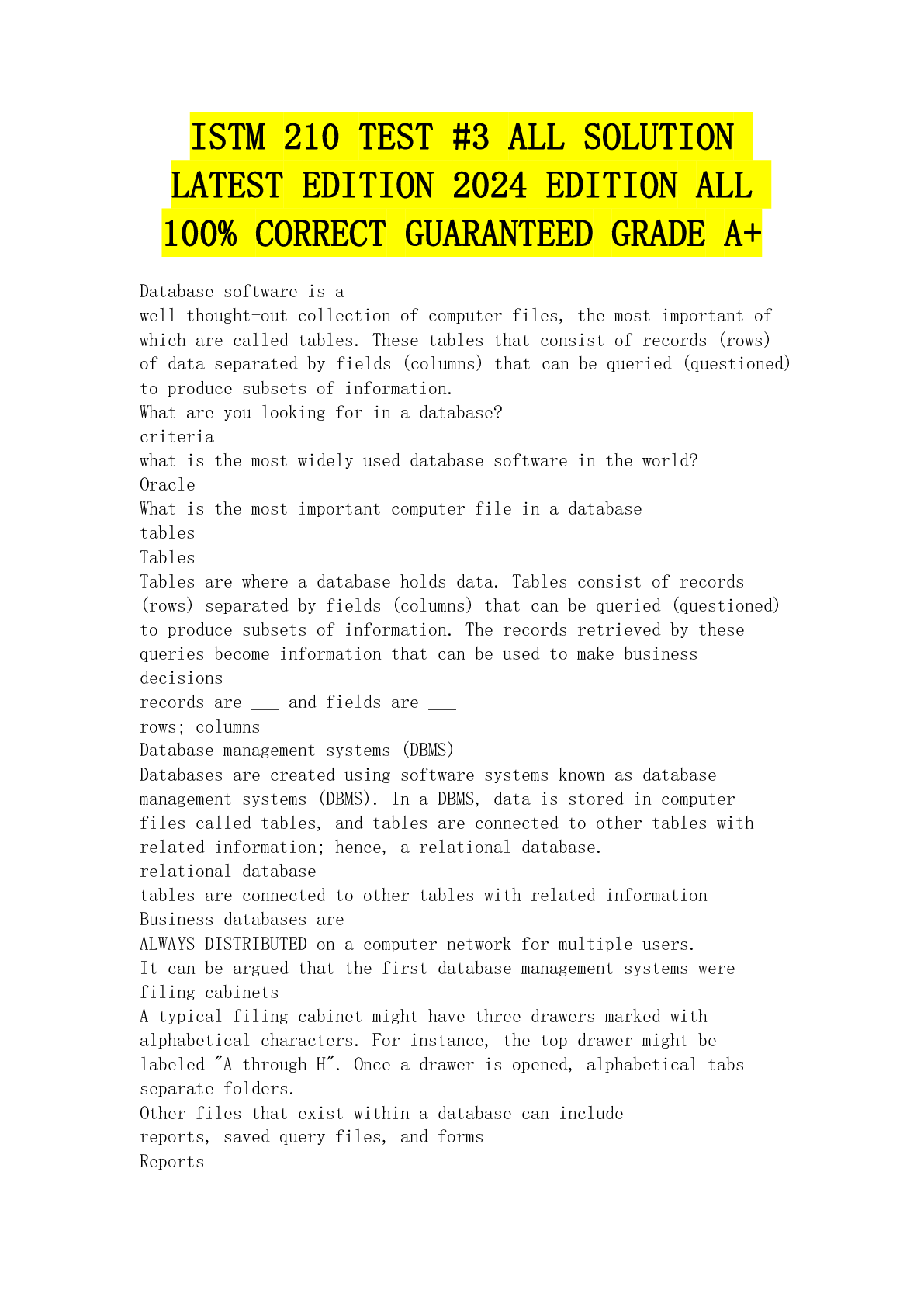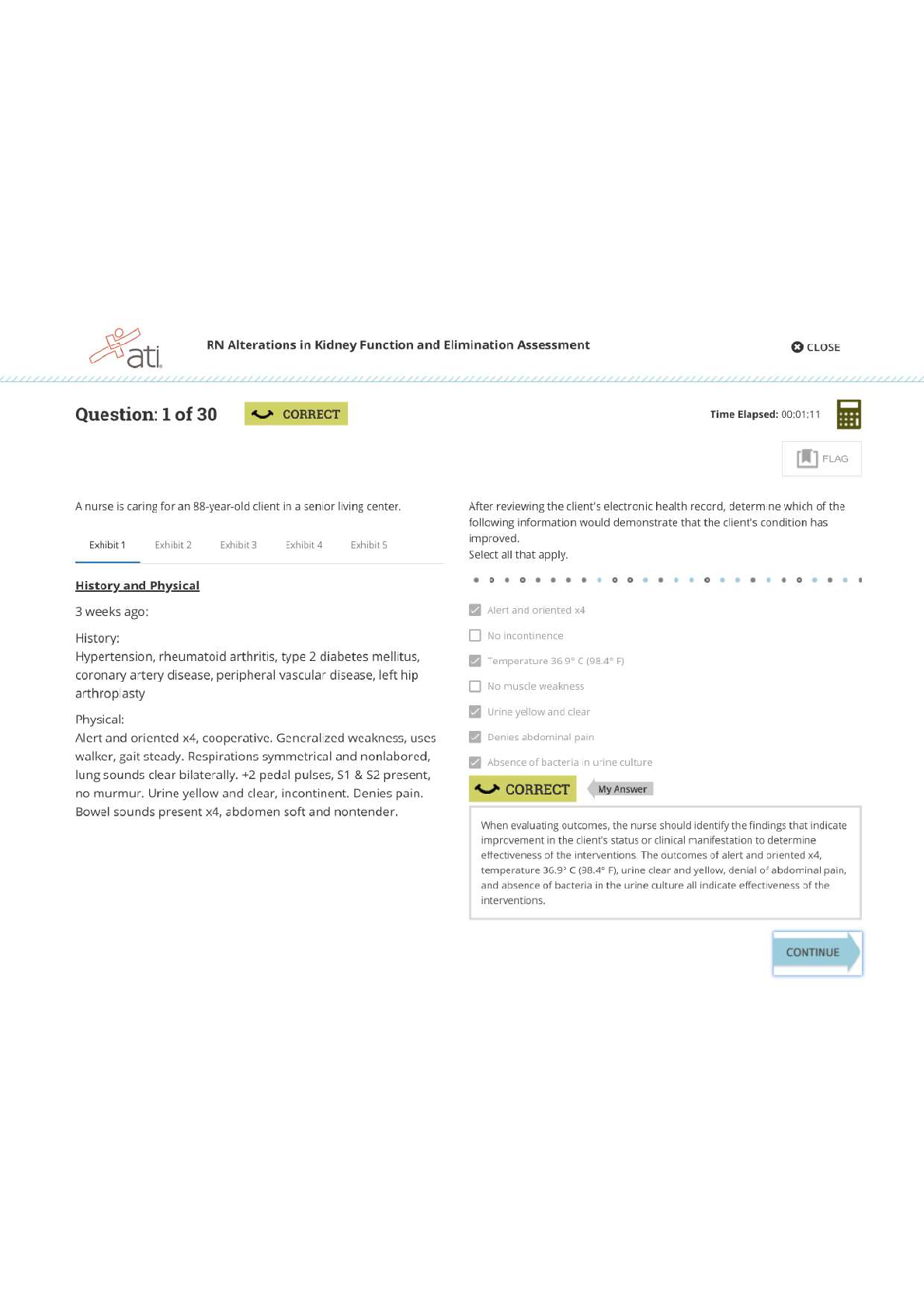PHYSICAL ASSESSMENT ALL SOLUTION LATEST EDITION 2024 GUARANTEED GRADE A+
Document Content and Description Below
Physical Assessment Method for gathering health data Assessment is 1st step of the nursing process and is ongoing throughout the nurse-patient relationship. It is process you use to collect physical... data relevant to the patient's health. Use four of your senses: sight, smell, hearing, and touch Goal: To gather objective data about a client. What is objective data? (measurable by nurse, classified as signs) What is subjective data? (verbalized by patient, not directly measurable, classified as symptoms) Clients are examined: on admission (comprehensive, in depth) briefly at the beginning of each shift (more focused) any time the client's condition changes When evaluating the effectiveness of nursing care Anytime things do not "feel right" PURPOSES of ASSESSMENT Evaluate client's current physical condition Detect early signs of developing health problems Establish a baseline for future comparisons (done on admission) Evaluate client's responses to medical and nursing interventions Monitor for changes in body function Detect specific body systems that need further assessment or testing There are 5 basic techniques: Inspection (look) Palpation (feel) Percussion Auscultation (listen) Olfaction (smell) 3 Levels of Physical Assessment 1. Comprehensive Health Assessment In-depth assessment of whole person (physical, mental, emotional, cultural, spiritual) Data is collected through physical exam and interview Generally done on admission to facility 2. Focused Assessment Exam and interview regarding a specific body system (ex. Respiratory system) Allows nurse to check only system related to patient's disease process or when performing reassessment of a system in which abnormal findings were obtained earlier 3. Initial Head-to-Toe Shift Assessment Quick overall assessment of patient's condition to establish baseline against which you can compare later assessments (able to identify changes in pt.'s condition: improvement or deterioration) Focused assessment of the following systems in sequence from head to toe: Neurological Cardiovascular Respiratory Integumentary Gastrointestinal Genitourinary Muscular Skeletal Also includes specific assessment of the patient's: Vital signs, including pain and O2 saturation (SpO2) Appearance Speech Safety risk factors Tubes and equipment Comfort or complaints Needs Findings such as VS and from other systems will provide some info. about Immune System Physical Assessment Abnormal findings should be reassessed within 4 hours or sooner depending on severity Some abnormal findings are minor or may even be expected Some abnormal findings may be totally unexpected and represent potentially serious conditions Example: patient is admitted with upper respiratory infection and you note an occasional dry cough. You instruct pt. to let you know if it gets worse. You would reassess the cough in 4 hrs. to see if better, worse, or same. Example: You assess a fever of 103 degrees. You need to take immediate action to treat fever and reassess in one hour Assessment Techniques Most important tools you will need are your eyes, ears, hands, nose, and critical thinking ability. Always wash your hands prior to assessment Interviewing (asking questions to determine the following): Personal identity and demographics Details of current condition (complaints, problems, reason for seeking medical care) Medical history Social history Food and drug allergies Height and weight Expectation for hospitalization Review Box 21-1, page 424-ways to foster rapport & communication Use therapeutic communication techniques (review chapter 6) INSPECTION Purposeful observation of anything about the body that you can see with naked eye or with use of equipment such as penlight, otoscope, etc... Most frequently used assessment technique Particular parts of the body are examined Look for specific normal and abnormal characteristics Need advanced instruction to use special instruments ex. To examine interior of the eyes (ophthalmoscope) Inspection begins with the first interaction with the client and continues throughout the exam PERCUSSION Least used nursing assessment technique Striking or tapping a part of the body with fingertips Fingertips produce vibratory sounds which aid in determining the location, size, and density of underlying structures (if structure is hollow or solid and containing air or fluid) Any unexpected sound can indicate a pathological change in that area Any pain can indicate a disease process or tissue injury PALPATION Lightly touching or applying pressure to the body Light Palpation-using the fingertips, back of hand, or palm of hand to feel surface of the skin, structures just beneath skin, pulsations from peripheral arteries, & vibrations in the chest (depress tissue between 1-2 cm) Deep Palpation-depressing tissue about 1 inch or 4-5 cm with forefingers of one or both hands (abdominal organs or masses) Palpation provides the following information: Size, shape, consistency, & mobility of normal tissue and unusual masses or growths -Symmetry or asymmetry of bilateral structures -Skin temperature, texture, and moisture use dorsal aspect of hand which is more sensitive to detect subtle differences in skin temp. (see Figure 21-2, page 425) Skin is normally warm and dry Questions to answer: Is skin warm or cool? Is it dry or moist? Diaphoretic=patient is perspiring Skin may be moist due to fever, exertion, anxiety Skin hot to touch=Does pt. have a fever? Is room temp. too hot? Too many blankets? Cool or cold skin=Is room temp. too cold? Poor circulation? -Any tenderness or pain -Unusual vibrations Skin turgor Edema Bladder or abdominal distention Location and strength of pulses Review cultural beliefs in assessment, page 425 AUSCULTATION Listening to body sounds Frequently used Lungs, heart, & abdomen most often assessed Need stethoscope (may be able to hear some sounds without any instrument) Ex. Loud bowel sounds, wheezing, belching, flatulence, or gurgling To ensure accuracy, eliminate environmental noise such as TV, talking, etc... Do not feel or listen through clothing (clothing can obscure or create sounds) Keep nails short and hands/stethoscope warm The diaphragm is used to listen to high-pitched sounds (normal heart sounds-S1 and S2, bowel sounds, breath sounds) The bell is used to listen to low-pitched sounds (abnormal heart sounds-murmurs, bruits-rushing of blood through vessel) Remember: Little side is for lower sounds Larger side is for higher sounds Olfaction Sense of smell used to detect odors characteristic of different health problems Examples: bad breath or halitosis can indicate poor oral hygiene, sinus infection or gastric upset Ammonia or urine smell to breath can indicate kidney failure or uremia Musty or sweet odor breath-liver disease Acetone or fruity smell to breath-diabetes out of control Cerumen with putrid smell -Pseudomonas infection Individuals with high stress levels often have sour-smelling breath Basic Physical Assessment Equipment Gloves Examination gown Cloth or paper drapes Scale Stethoscope Sphygmomanometer Thermometer Pen light/flashlight Tongue blade Assessment form and pen ENVIRONMENT Nurses assess clients in a special exam room or at the bedside Area should have: Access to restroom Privacy Warmth Padded, adjustable bed or table Adequate lighting Sufficient room on either side of client Sink for handwashing/hand hygiene Clean surface for exam equipment Receptacle for soiled items Sheet or paper drape for client to provide modesty and some warmth Gathering General Data First contact with client, nurse should make an overall assessment of general condition By observing and interacting with the client the nurse should note the following prior to exam: Clothing and hygiene Level of consciousness Body size Posture Gait, coordinated movement or not Any ambulatory aids Mood and emotional tone Comfort level Any signs of distress Skin color Response to voice upon entering room Eye contact Breathing (mouth or nose, any respiratory distress noted) Preliminary Data Vital signs-provide a baseline for future readings B/P, T, P, R, SpO2, and pain level Height Weight-provides baseline to assess future losses or gains, also to calculate some drug dosages Standing scale, electronic bed or chair scale Nursing guidelines for obtaining weight: Make sure scale is calibrated at zero Have patient remove shoes, should wear minimal clothing Place paper towel on scale if patient is barefoot Obtain daily weights at same time each day Approaches for Data Collection Nurses should conduct assessment consistently each time to avoid omitting essential information Head to Toe (top of body to feet) Helps prevent overlooking an area Reduces # of position changes of the client Takes less time Body Systems (examine structures in each functional system separately) Ex. Cardiovascular system- assess peripheral pulses, listen to heart sounds, etc... Nurse examines same areas of body several times and client has to make frequent position changes which may tire him/her Review Table 21-1, pages 427-428 Assessment Components Related to Body Systems Who Knows the Answer? You have to assess (2) new clients. One arrived by wheelchair and is walking around the unit. The other came by ambulance with IV fluids and oxygen. Which client will you assess first. Why? DATA COLLECTION Divide the body into (6) general areas Head and neck Chest and spine Extremities Abdomen Genitalia Anus and rectum Head and Neck ... Level of Consciousness Continuum from alert to comatose Note if patient is alert or lethargic-drowsy, mental sluggishness Alert = pt. is wide awake and responds to questions spontaneously If pt. does not respond to verbal stimulus, use tactile or touch If pt. does not respond to touch, apply slight pressure on sternum or nail bed to produce discomfort and see if any response Comatose = no response to painful stimuli, unconsciousness from which pt. cannot be aroused (see Glasgow Coma Scale, page 430) Basic questions to ask: (PERSON) What is your name?, Who is president of the US? (PLACE) Can you tell me where you are? (TIME) What is today's date?, What day is it? (SITUATION) What problem brought you to hospital?, Do you know why you are here? NOTE: If pt. is nonverbal, you cannot document that pt. is disoriented. You need to put unable to assess orientation due to mental status or being nonverbal Speech is speech appropriate, clear, and easy to understand? Is speech rambling, incoherent, inappropriate, or slurred? Aphasia=abnormal neurologic condition in which language function is disordered or absent due to injury of cerebral cortex (expressive or receptive) Dysphasia=difficulty coordinating and organizing words correctly in a sentence Eyes Normal Findings Similar size and distance from center of face Each iris same color Sclerae appear white, smooth, glistening In dark-skinned patients, may have a normal, slightly darker cast around outside edges Corneas clear Eyelashes present Conjunctiva appear pink and moist Advanced practitioners use ophthalmoscope to examine internal structures Abnormalities might include: Redness or bloodshot-inflammation, lack of sleep, or allergies Yellowish-orange color of sclera-increased bilirubin (jaundice) Opaque white ring around outer edge of cornea-arcus senilis Cloudiness-infection or vitamin A deficiency Opaqueness of lens-cataract Visual acuity-ability to see both near and far Does client wear glasses or contacts, have false eye, or is blind? Assessment of vision without any eye charts or instruments: Gross far vision Ask client to cover 1 eye at a time , stand at distance of 20 feet, count # of fingers nurse holds up Near vision Asks literate clients to read newspaper print from about 14 inches away Eyes Snellen Eye Chart (tool for assessing far vision) Each line on chart printed in progressively smaller letters or symbols (large at top getting smaller towards the bottom) Nurse asks client to read smallest line he/she can see from 20 feet with and without corrective lenses Compares client's vision against norms Normal vision-can read printed letters most people can see at a distance of 20 feet without corrective lenses (20/20) If at 20 feet from the chart, a person can only see the first line of printed letters which is very large, that person's visual acuity is 20/200 because people with normal vision can see that first line from 200 feet away Jaeger Chart (tool for assessing near vision; chart has small print) Snellen Chart Snellen Chart 1st number=number of feet from the chart the client is standing 2nd number=distance at which a normal-sighted person can read the line *The line for which two or fewer letters are missed is recorded as the visual acuity. (20/20 is normal) Question: A client asks what her Snellen eye test results mean. Her acuity for both eyes together is 20/30. Which of the following is the appropriate response? You can see at 20 ft what the normal-sighted person sees at 30 ft D. You can see at 50ft what the normal-sighted person sees You can see at 30 ft what the normal-sighted person sees at 20ft at 20ft You can see at 10ft what the normal-sighted person sees at 50ft EYES (cont'd) [Show More]
Last updated: 3 months ago
Preview 1 out of 18 pages
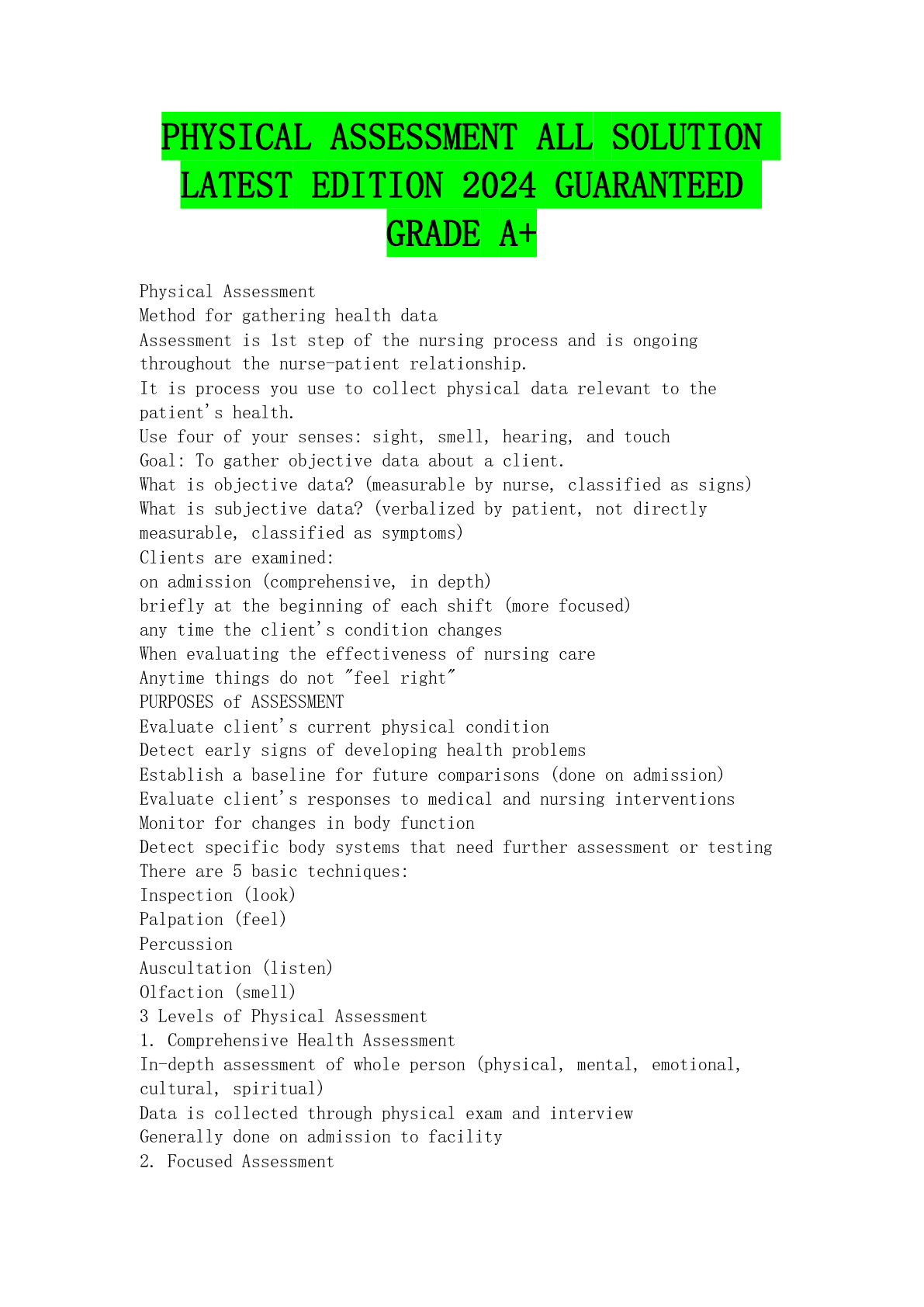
Reviews( 0 )
Document information
Connected school, study & course
About the document
Uploaded On
Jan 15, 2024
Number of pages
18
Written in
Additional information
This document has been written for:
Uploaded
Jan 15, 2024
Downloads
0
Views
38




